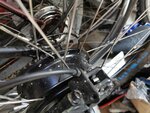okidoki
New Member
Hi Everyone,
Today I noticed that the spokes on my NCM Moskow look very strange. The spoke that is attached to the inner side of the hub goes over the spoke that is attached to the outer side of the hub. In other words, the spokes push each other and create unnecessary tension on each other. The first picture is from this web site and looks normal. The second one is my bike, which seems strange. I have read some reviews related to breaking spokes. Can this be the reason? Is it a manufacturing defect? Dou you think it is necessary to rebuild?
(This picture is from the review page of this web site)

(this picture is from my bike)

Today I noticed that the spokes on my NCM Moskow look very strange. The spoke that is attached to the inner side of the hub goes over the spoke that is attached to the outer side of the hub. In other words, the spokes push each other and create unnecessary tension on each other. The first picture is from this web site and looks normal. The second one is my bike, which seems strange. I have read some reviews related to breaking spokes. Can this be the reason? Is it a manufacturing defect? Dou you think it is necessary to rebuild?
(This picture is from the review page of this web site)
(this picture is from my bike)
